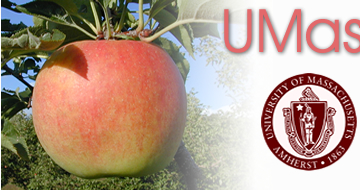| pages: previous 1 2 3 4 5 6 7 8 9 10 11 12 13 14 next |
|
Hawkeye
Delicious. 'Hawkeye' is the name first given to the original
Delicious that was discovered in Iowa in about 1872. It was later named
Delicious by Stark Brothers Nursery. It is a somewhat typey apple with
a somewhat bleached red color. Flavor is good and fruity. It only slightly
resembles in taste and appearance the Delicious grown and sold commercially
today. Many mutations have been selected over the years that are cosmetically
pleasing, but often times this comes at the expense of taste and eating
quality.
Hudson Golden Gem is the largest of the fully russetted apples that are available today. It is conical with a yellow somewhat rough russet skin. The fruit tastes sweet. Its taste is very similar to a pear as is its texture. Some describe the favor as nutty. It is a high-quality apple. It may crack in the spring when fruit are about an inch in diameter, but this is not observed every year. It does display some preharvest fruit drop, thus a drop-control agent may be useful.
|
|
 |
Liberty was one of the first disease-resistant apples
to be released by Cornell (1978). It is medium to small in size with
a striped red color over a green-yellow background. Flesh is yellowish
when fully mature, fine, crisp, juicy, with a tart/sweet (sprightly)
flavor. It is similar in appearance and ripens at about the same time
as Empire. While size may be small, it can be improved with aggressive
thinning, and quality on the tree can be maintained with the use of ReTain.
Liberty is wholly resistant to apple scab.
|
MN 1914 is a restricted variety from the University
of Minnesota that is the result of a cross made between Honeycrisp and
Zestar!. It is a nearly full-red, medium-to-large apple that appears
to maintain quality on the tree for an extended period of time. It is
crisp and juicy, and it has a very complex taste profile. It is unnamed
at this time, and the availability is still in question. However, growers
in Washington, Minnesota, and Nova Scotia have been licensed to grow
this variety. Although apparently well adapted to our growing conditions,
it is likely Massachusetts growers will not be allowed to grow this apple
for the foreseeable future.
|
|
| pages: previous 1 2 3 4 5 6 7 8 9 10 11 12 13 14 next |



